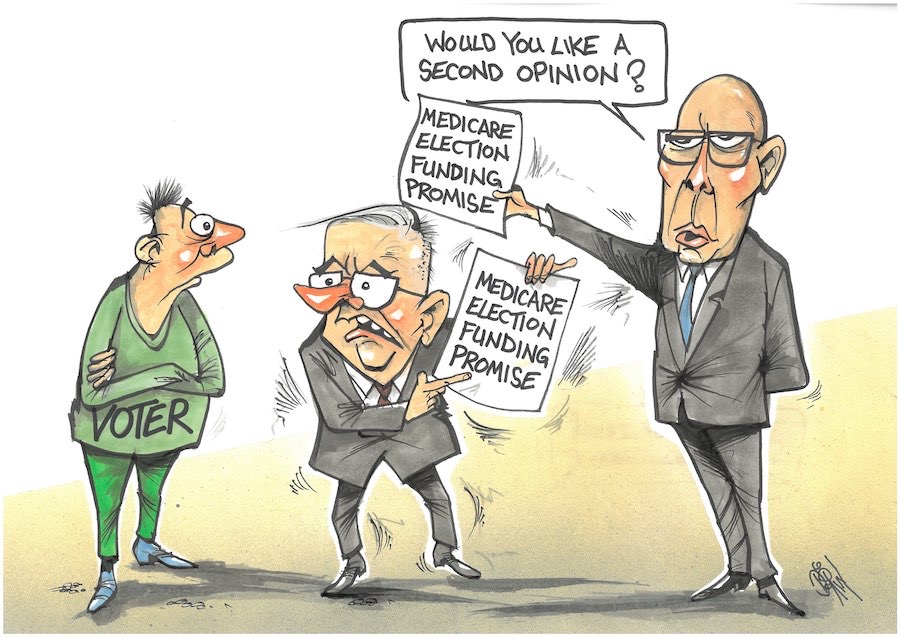
“With an operating deficit of $1 billion and net debt tracking to $12 billion, it’s reasonable to ask whether the woeful state of the ACT budget may justifiably be attributed to this single project.” JON STANHOPE & KHALID AHMED take a forensic look at light rail.
Canberra light rail is a common subject of conversation and a regular topic in columns and letters to the editor.
And also in various contexts, for example, the financial position of the ACT, planning and changes to the urban form, potential technological alternatives, and routes and alignment of the network.
While there appears to have been a decline in the level of support for the project, it is fair to say that the community is deeply divided on its merits. For a project of such scope, cost and impact, the lack of interest or leadership from the government in forging a broad consensus is regrettable.
For its part, the ACT government, and supporters of the project, have claimed that it has received a “mandate” through successive elections. We disagree.
There has been no referendum on this issue, and except for the 2024 election campaign, in which the Canberra Liberals declared its opposition to the project, it did not have a clear position.
Opposition was dared to cancel the contract
In fact, major contract commitments had been made in the lead up to the 2016 and 2024 election, with the underlying message being that light rail was a foregone conclusion and the opposition was dared by the government to cancel the contract.
In any event, regardless of the level of support for light rail, around half or marginally more people did not vote for the Labor-Green Coalition in those elections.
Nevertheless, stage 1 of the project (a 14-kilometre line from Gungahlin to Civic) is complete, and stage 2a (the 1.7-kilometre extension to Commonwealth Park) has begun.
With the recent release of the Budget Review, which revealed an annual operating deficit of more than a billion dollars, and net debt currently exceeding $9 billion and tracking to more than $12 billion within a few years, it is reasonable to ask whether the woeful state of the ACT budget and its overall finances may justifiably be attributed to this single project.
Has the horse bolted?
The more pragmatic among us may also insist as far as the tram is concerned the “horse has bolted” and that it would be best to turn to more fundamental issues impacting the finances.
Some also argue that the ACT is in such poor shape because its finances are structurally not viable due to its narrow economic/tax base. Notably this argument has not been raised by government ministers, although from time to time, they may find it politically convenient to deprecate the federal government.
In a number of previous columns, we have sought to explain the overall basis of Commonwealth-State financial relations. It is a transparent and principle-based system that, in our opinion, is the fairest in distributing resources among the states and territories.
The federation (nation) as a whole may have transient challenges from global shocks (for example, the pandemic), or even emerging structural imbalances (for example, an ageing population or stagnating productivity), that may require policy responses.
However, no state or territory is fundamentally any less viable than others, with the system delivering an “equalised” capacity, even running a steamroller over any special bilateral deals – each has to be accountable for its performance if it varies significantly from others over time.
It is, therefore, not without irony that ministers announcing a special deal with the Commonwealth for a capital works project are aware that they would have received this money anyway, and if it were more than a fair share, it would be taken away under some other head.
The argument of structural financial disadvantage, with respect, comes from either a genuine lack of understanding of a complex – and boring in its detail – system, or a well-considered and convenient disregard of it to detract and misdirect public discussion.
Turning to the more substantial question of the impact of the light rail project on the territory’s finances: publicly available financial information shows that the project has had a significant impact quantitatively, and, in our opinion, a formative impact qualitatively on the territory’s finances and its financial management, respectively.
Stage 1 was delivered through a Public Private Partnership (PPP) arrangement. The government made an upfront capital contribution of $375 million, with the remainder of the capital costs (including any cost overruns over the original $614 million estimate) as well its operating and maintenance costs being bundled into a commercial contract over 20 years.
The cost of the contract was disclosed in the 2015-16 audited financial statements (Note 58, Page 101) as $1.649 billion. In reality, the costs are certain to be higher, in the order of $2 billion because, as noted by the auditor-general, some capital and recurrent costs were excluded from the contract. As a result of changes to accounting standards, these costs are now recognised as liabilities.
Should the ACT have borrowed the lot?
A serious question raised by these arrangements is whether the ACT government could or should have borrowed the entire capital amount with its AAA credit rating, rather than allowing the consortium (which had a financing partner) to charge an almost certainly higher commercial rate.
The financing costs as well as the interest rate factored into the contract cost have not been publicly disclosed for reasons, apparently involving commercial confidentiality.
However, we have a clue, of the likely cost, from a reference to the discount rate used by the consortium, as being 7.52 per cent. Conceptually, “interest rate” and “discount rate” are related although not the same. In the absence of any specific information from the government, it is reasonable to assume the financing cost was 7.52 per cent. By way of comparison, in 2016 the cost of borrowing through a AAA-rated bond would have been between 2 per cent and 3 per cent.
The ACT government has advised that the cost of the Stage 2A contract is $577 million which entails, of course, an increase in debt of that amount.
However, this price excludes significant costs related to associated works such as the raising of London Circuit. The total bundle of costs (capital, financing and maintenance) will become visible in the financial statements in coming years. Notably, some observers have estimated that these additional costs may exceed $1 billion and be as high as $1.5 billion. Notably the financial commitments, to date, are in the order of a third of the annual ACT budget.
It has been argued that since Stage 1 commitments are to be paid off over a period of 20 years, and that surely around $80 million in an overall budget spend of around $5 billion at the time, ie in 2016, was affordable and so could not possibly have broken the budget.
While, of course, the dire state of the ACT’s finances cannot be attributed to just this one project it is moot that there was “free” $80 million floating around in the budget at the time.
In general, sub-national governments’ budgets have limited flexibility, more so if there is an existing deficit, which was and has remained the case in the ACT.
Constituting around 5 per cent of the taxation revenue, this new spending commitment consumed at the time the totality of real tax growth that was required for other existing services, such as health and education.
The light rail project has had a much greater impact on financial management than the simplistic comparisons of contract payments with the overall budget would suggest. We will discuss these in further detail in a subsequent article.
Is this discussion of any benefit? The scope of the project outlined in 2016 was a citywide network of more than 90 kilometres, and as such, only a fraction of the project has been completed. With more stages to come, and both the ACT and Commonwealth Government’s refusing point blank to release the business case or a cost-benefit analysis to inform discussion on the merits of the project and lessons learnt. We believe further analysis and community engagement is fundamentally important.
Jon Stanhope is a former chief minister of the ACT and Dr Khalid Ahmed a former senior ACT Treasury official.
Who can be trusted?
In a world of spin and confusion, there’s never been a more important time to support independent journalism in Canberra.
If you trust our work online and want to enforce the power of independent voices, I invite you to make a small contribution.
Every dollar of support is invested back into our journalism to help keep citynews.com.au strong and free.
Thank you,
Ian Meikle, editor








Leave a Reply